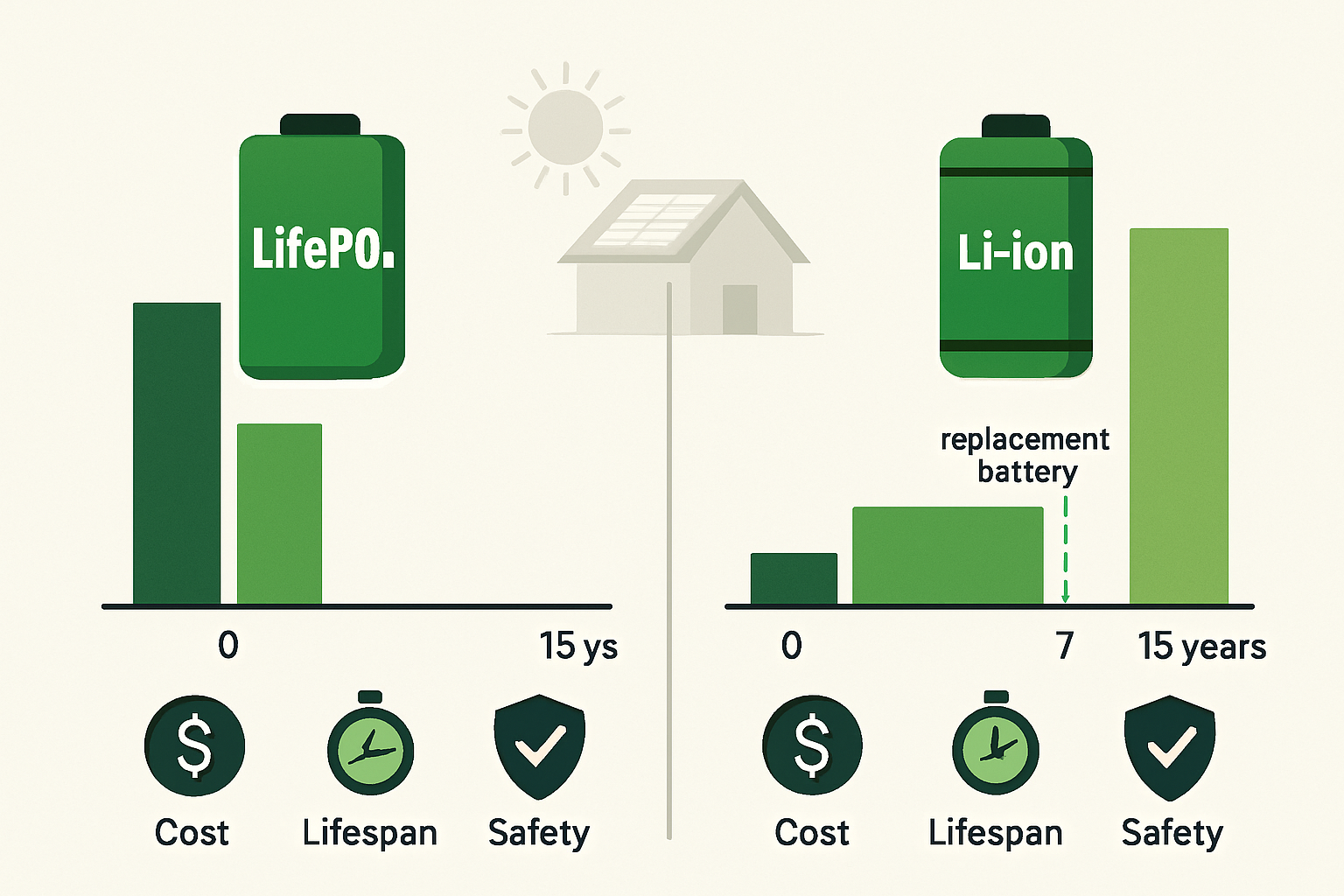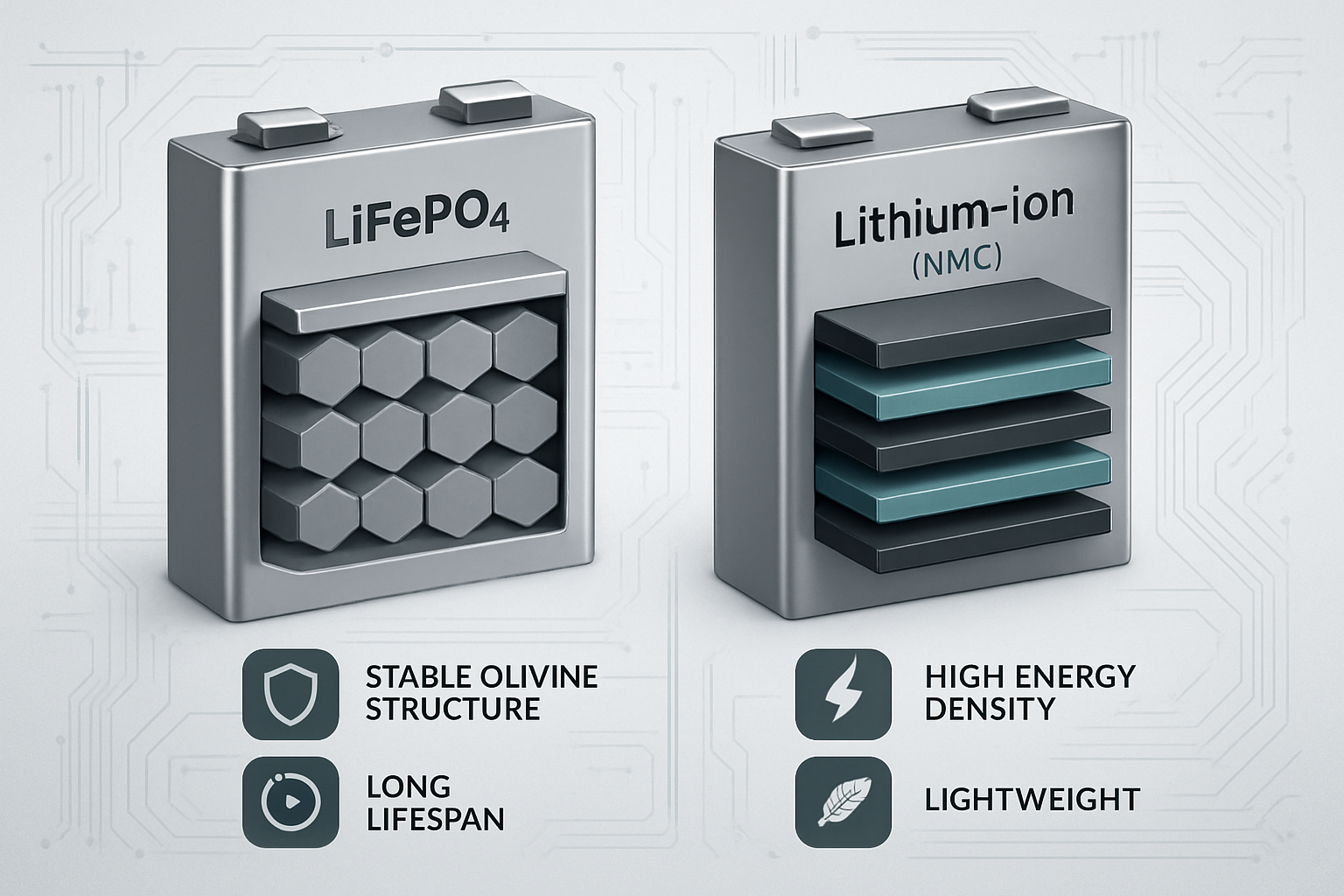Selecting the right 100Ah battery is a critical decision for any solar energy storage, RV, or off-grid application. While many batteries fall under the 'lithium-ion' umbrella, the specific chemistry inside makes a significant difference. The two most prominent types are Lithium Iron Phosphate (LiFePO4) and Nickel Manganese Cobalt (NMC). Understanding their distinct characteristics is key to ensuring your system is safe, reliable, and cost-effective in the long run.
Safety First: The Chemical Stability Showdown
The most critical distinction between LiFePO4 and other lithium-ion chemistries like NMC is safety. This comes down to their fundamental chemical structures and how they react under stress.
Thermal Runaway Resistance
LiFePO4 batteries are known for their exceptional thermal stability. The phosphorus-oxygen bond in the LiFePO4 cathode is incredibly strong, making it much less prone to breaking down and releasing oxygen, even at high temperatures. This structural integrity gives LiFePO4 a significantly higher thermal runaway threshold, igniting at around 270°C (518°F). In contrast, NMC chemistries are more susceptible to thermal runaway at lower temperatures, around 210°C (410°F). This makes LiFePO4 a safer choice for home energy storage and applications where the battery might be exposed to heat.
Response to Damage
In the event of physical damage, such as a puncture or impact, LiFePO4 cells are far less likely to combust or explode. Their stable structure resists the rapid, uncontrolled release of energy that characterizes thermal runaway in other lithium-ion types. Research from the U.S. Department of Energy's National Renewable Energy Laboratory (NREL) has highlighted the inherent safety advantages of the LiFePO4 structure, which eliminates the use of cobalt, a more volatile and toxic material found in NMC batteries. This stability is a primary reason they are preferred for stationary applications where safety is a top priority.
Lifespan and Long-Term Value
While the initial purchase price is a factor, the true cost of a battery is revealed over its lifetime. This is where LiFePO4 technology demonstrates a clear advantage.
Superior Cycle Life
A 'cycle' is one full charge and discharge. A 100Ah LiFePO4 battery can typically endure between 3,000 and 7,000 cycles before its capacity degrades to 80% of its original state. In comparison, a standard 100Ah lithium-ion (NMC) battery generally offers 1,000 to 2,000 cycles. For a system that is used daily, like a solar energy storage system, this means a LiFePO4 battery can last for a decade or more, while an NMC battery might need replacement much sooner.
Depth of Discharge (DoD)
LiFePO4 batteries can be regularly discharged to 100% of their capacity without significant damage, offering more usable energy. NMC batteries, however, perform best when kept between a 20% and 80% state of charge to prolong their life. This means that to get the same usable energy as a 100Ah LiFePO4 battery, you might need a larger, higher-capacity NMC battery pack. A comprehensive look at solar storage performance shows how factors like DoD directly impact a system's real-world output and long-term value.
Performance and Energy Density
Performance is not just about power; it's about how efficiently that power is stored and delivered. Here, the choice between LiFePO4 and NMC involves a trade-off between energy density and stability.
Energy Density Explained
Energy density refers to the amount of energy a battery can store relative to its weight or volume, often measured in watt-hours per kilogram (Wh/kg). NMC batteries have a higher energy density, typically ranging from 150-250 Wh/kg. LiFePO4 batteries have a lower energy density, usually between 90-160 Wh/kg. This means that for the same capacity, a 100Ah NMC battery pack will be lighter and more compact than a 100Ah LiFePO4 battery. This is why NMC is often favored for portable applications where weight and space are critical constraints.
Application-Specific Performance
For stationary applications like home energy storage, the slightly larger size and weight of a LiFePO4 battery are less important than its safety and longevity. The consistent power output and stable voltage of LiFePO4 are ideal for powering household appliances reliably. According to the International Energy Agency (IEA), LFP (LiFePO4) is the fastest-growing battery chemistry for both electric vehicles and stationary storage due to its lower cost and longer cycle life. A 2020 report from the U.S. Department of Energy also found that large-scale energy storage systems built with LFP were less costly per kWh and were projected to last significantly longer than NMC systems.
| Feature | LiFePO4 (LFP) | Lithium-Ion (NMC) |
|---|---|---|
| Cycle Life (to 80% capacity) | 3,000 - 7,000+ cycles | 1,000 - 2,000 cycles |
| Safety (Thermal Runaway) | Very high (approx. 270°C) | Lower (approx. 210°C) |
| Energy Density | 90 - 160 Wh/kg | 150 - 250 Wh/kg |
| Usable Capacity (DoD) | Up to 100% | Recommended 60-80% |
| Primary Advantage | Longevity and Safety | Compact Size and Weight |
Making the Right Choice for Your Needs
When choosing a 100Ah battery, the decision hinges on your application's priorities. If you need a lightweight, compact power source for a portable device, an NMC lithium-ion battery may be suitable. However, for applications demanding high safety, reliability, and a long service life—such as solar energy storage, RVs, marine use, or off-grid living—a 100Ah LiFePO4 battery is the superior choice. Its chemical stability, extensive cycle life, and excellent total cost of ownership provide lasting value and peace of mind.
Frequently Asked Questions
Is a 100Ah LiFePO4 battery a deep cycle battery?
Yes, LiFePO4 batteries are a type of deep cycle battery. They are designed to be regularly discharged to a low state of charge without sustaining damage, which makes them ideal for applications that require sustained power over long periods, like solar energy storage or powering an RV.
What is the main difference between a 100Ah LiFePO4 and a 100Ah NMC battery?
The primary differences are in safety, lifespan, and energy density. A 100Ah LiFePO4 battery is significantly safer, has a much longer cycle life (often 3-5 times more cycles), but is slightly heavier and larger. A 100Ah NMC battery is more compact and lighter but has a shorter lifespan and a lower thermal stability threshold.
Can I use the same charger for both LiFePO4 and other lithium-ion batteries?
It is not recommended. Different lithium chemistries have specific voltage requirements for charging. Using a charger designed for NMC on a LiFePO4 battery, or vice versa, can lead to incomplete charging, reduced lifespan, or even damage to the battery. Always use a charger that is specifically designed for your battery's chemistry.





Leave a comment
All comments are moderated before being published.
This site is protected by hCaptcha and the hCaptcha Privacy Policy and Terms of Service apply.